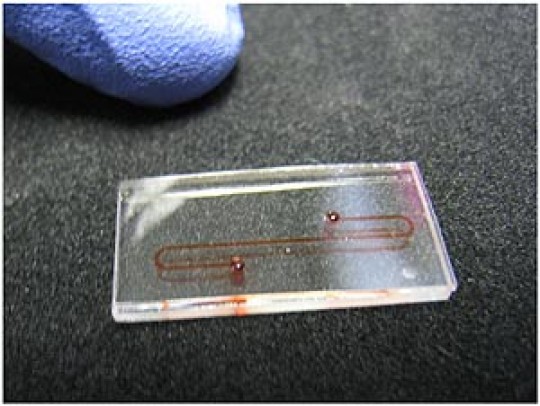New Stanford immune-system sensor may speed up, slash cost of detecting disease
New Stanford immune-system sensor may speed up, slash cost of detecting disease
An inexpensive new medical sensor has the potential to simplify the diagnosis of diseases ranging from life-threatening immune deficiencies to the common cold, according to its inventors at the Stanford University School of Medicine.
Their device, called an integrated microfluidics-waveguide sensor, sorts and counts cells in small samples of blood and other body fluids. The developers say the sensor provides an easy way to measure different types of white blood cells, a key component of the immune system. They add that the sensor, which is about the size of an adult’s thumbnail, could be deployed in doctors’ offices, newborn nurseries, patients’ homes, disaster sites and battlefields.

Manish Butte
“A low-cost way of counting cells could provide point-of-care diagnosis and monitoring for immune disorders, allergies, infections, AIDS, cancer and other disorders,” said Manish Butte, MD, PhD, who led the team of inventors. Butte is an assistant professor of pediatrics at Stanford, a pediatric immunologist at Lucile Packard Children’s Hospital and the senior author of a paper describing the sensor that appeared online March 7 in Biomicrofluidics. Stanford University has filed for a patent on the device; the inventors are seeking a partner to commercialize the sensors.
Butte developed the sensor because he wanted a better way to screen newborns for severe combined immunodeficiency, a congenital illness commonly known as “bubble boy disease” in which infants are born with much of their immune system missing. The disease affects about one in 100,000 infants. California’s current method for screening newborns for this disease takes three to six weeks to return results, by which time some affected infants could contract life-threatening infections. In contrast, the new sensor has the potential to detect low T-cell counts, a hallmark of the disease, in a 15-minute test in the newborn nursery before a new baby goes home from the hospital.
Butte soon realized, however, that the sensor had the potential to aid in diagnosing a wide range of conditions.
The body has many types of white blood cells, each with different disease-fighting roles. White blood cell counts already help doctors diagnose some diseases and monitor treatment of others, including cancer and AIDS, but current cell-counting methods require fairly large blood samples and costly, slow equipment that can be operated only by trained laboratory technicians.
One possible application of the new sensor would allow doctors to solve a common, vexing problem: determining the cause of a runny nose. Instead of using the current trial-and-error method for diagnosing the problem, doctors could take a mucus sample from the patient in their office and measure the white blood cells present. Elevation of one type of white blood cells could implicate allergies, another cell type could point to a sinus infection and a third type of elevated cell count could suggest that the runny nose was simply due to the common cold.

The new sensor consists of a small, rectangular piece of glass impregnated with a strip of potassium ions. The potassium-impregnated glass acts as a “waveguide” — laser light shone into the strip of glass is transmitted down it in a specific way, and the light emitted from the far end of the waveguide can be measured with a light sensor.
To operate the detector, a patient’s fluid sample is mixed with antibodies specific for the particular type of white blood cell to be measured. Each antibody is attached to a tiny bead of magnetic iron. Then, the sample is injected in a small channel on top of the glass waveguide. A magnet under the glass traps the labeled cells in the channel. The iron beads block a bit of the laser light that would otherwise pass through the waveguide, and this reduced transmission is measured by the light sensor at the far side of the glass.
The prototype sensor cost about $60 to build using off-the-shelf electronics components, Butte said, adding that the per-unit cost would be lower if the sensors were manufactured in bulk. In comparison, laboratory machines now used to count cells cost tens of thousands of dollars.
Butte noted that the sensors could be used by patients as well as by health-care providers.
“Catching infections early is important for many patient populations,” Butte said, adding that he hopes such patients — including those who have received organ transplants, suffer chronic kidney failure or are taking immune-suppressing drugs to treat rheumatoid arthritis — could use the sensors to monitor their immune systems much in the way that diabetics use glucometers to track their blood sugar at home.
Butte’s Stanford collaborators on the project are postdoctoral scholar Daniel Garcia, PhD, and Isaac Ghansah, a biology undergraduate student.
The research was funded by grants from the SPARK translational research program at the School of Medicine, the National Institute of Allergy and Infectious Disease, the Center for Integration of Medicine and Innovative Technology and the Massachusetts Technology Transfer Council.
By Erin Digitale
Stanford University Medical Center
###
* Stanford University Medical Center integrates research, medical education and patient care at its three institutions – Stanford University School of Medicine, Stanford Hospital & Clinics and Lucile Packard Children’s Hospital.
** The above story is adapted from materials provided by Stanford University School of Medicine
________________________________________________________________



















